Through the first two weeks of the NFL season, Washington Redskins' cornerback Josh Norman hasn't shadowed the opposing team's top receiver. That has sparked plenty of debate about the best way to cover the NFL's elite pass-catchers, as Antonio Brown and Dez Bryant both made big plays when Norman didn't shadow their every move.
I want to be clear: Shadowing an opponent's top wide receiver isn't always the answer to building a smart defensive game plan. With Norman and the Redskins changing their philosophy versus Odell Beckham Jr. this weekend, let's first look at what not to do when defending a team's No. 1 receiver, before digging into three coverages that defenses should use more.
Avoid static single-high looks
Let's start with Week 1 Monday Night Football, when Brown went off for 126 yards and two touchdowns versus the Redskins. With Norman lined up as the left CB on 81 percent of snaps, Brown went to work on Bashaud Breeland, beating the young defensive back over the top (twice).
But where was the help? Where was the game plan to limit the explosive ability of the best wide receiver in the game? Think about it: Matching up to AB in a one-on-one situation is a tough job for anyone in the league -- especially when there is no immediate help over the top versus the deep ball. And if your top cornerback isn't going to check Brown, you need to adjust your scheme to take the Steelers' No. 1 receiver out of the game.
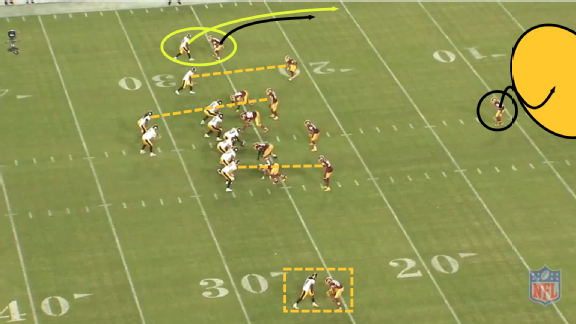
When Ben Roethlisberger walks to the line of scrimmage, he sees straight man coverage or Cover 1. No real disguise. Just line up and play. This is preseason stuff from the defense. And it automatically puts Breeland in a tough spot while giving Roethlisberger the exact look he wants to attack. With free safety DeAngelo Hall aligned as the deep middle defender, Roethlisberger knows he has Brown in a true one-on-one matchup to throw the fade.
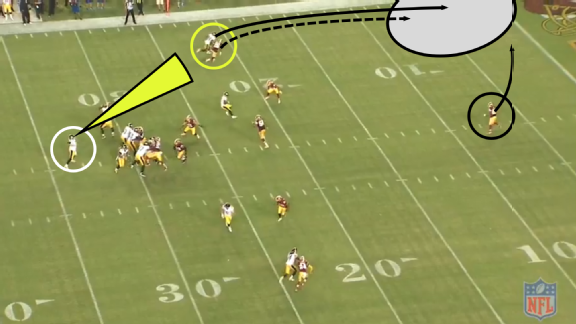
When I was watching the tape, you know the first thing that jumped out to me? Roethlisberger's eyes at the snap. He didn't open his shoulders to the opposite side of the formation or hold the free safety over the top. Instead, he took the snap and immediately stared Brown down. Why? Because of the defensive look from the Redskins. Roethlisberger knew that Hall couldn't make it over the top due to his pre-snap alignment. No chance.
With one-on-one all the way, Big Ben delivers a perfect throw -- ball on the outside shoulder, away from Breeland's leverage. Now, one could say that Breeland has to jam, or has to reroute Brown and then stack on top of the fade. I get it. That's coachspeak in the defensive back meeting room. But it's not that easy. Brown is electric off the release and his acceleration is legit.
This is nothing more than poor game planning from the Redskins. It's one thing to take Norman -- who doesn't usually travel with receivers -- and align him on the left side of the defense. That caters to his skill set more in Washington's zone schemes. But when you essentially leave Breeland on an island, with no true help to impact the deep ball, you are asking for trouble.
So how would I game plan a receiver like Brown, Beckham, Julio Jones, DeAndre Hopkins or A.J. Green? Put the No. 1 cornerback on the opposition's No. 2 wide receiver and use the scheme to take away the top wide receiver. No different than what the New England Patriots used to do with Darrelle Revis.
Here are three ways to get that done -- drawn up for you to see.
Roll to 3 Cloud coverage
Playing 3 Cloud allows the defense to disguise and roll a safety over the top of the No. 1 wide receiver. It's a true three-deep coverage that can cause some confusion in the quarterback's read (late safety rotation, cornerback squatting in the flat). And it also gives the defense the chance to reroute that top WR at the line, with help waiting over the top.
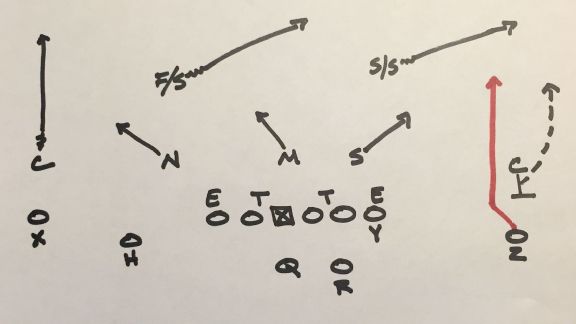
3 Cloud can look like straight Cover 2 or even quarters (Cover 4) in the pre-snap alignment, but the key is to roll the coverage toward the No. 1 WR (the Z in the above diagram).
At the snap, the strong safety (SS) rolls to the outside one-third (three-deep) and the free safety (FS) rolls to the deep middle of the field. That allows the cornerback (C) to jam (force an inside release) and sink to protect versus the corner route. With the weakside cornerback dropping to the deep third, and the underneath defenders (N-M-S) playing Cover 3 technique (curl-hook-hook), this is essentially a three-deep coverage with a rolled-up corner.
You still want to throw that fade route? Go ahead -- because we are going to pick it off. Time to go somewhere else with the ball.
Pressure and bracket the slot alignment
Remember, that No. 1 wide receiver isn't going to stand in cement all day as the X or Z receiver outside the numbers. He's going to reduce his split, go in motion and also align inside as the slot receiver -- all in an effort to create a favorable matchup. So we have to put together a plan for that too.
This is an old Gregg Williams pressure scheme out of the Ruby package (3DL-2LB-6DB) from his days as my defensive coordinator in Washington. The call? Ruby Scorpion 77 Dime. It allowed us to bring secondary pressure (strong safety blitz) while also doubling the slot receiver.
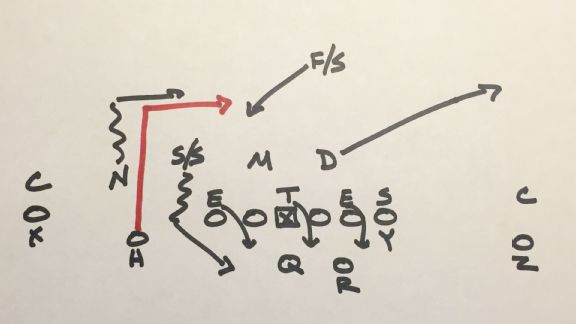
This is a combination coverage, meaning it requires defensive backs to communicate based on the offensive formation and alignment. With the No. 1 WR in the slot, the call would be a "slice." That tells the nickel corner (N) and the free safety (FS) to bracket the receiver (H). And like most NFL coverage schemes, there is movement and disguise as the Dime (D) drops to the deep half. That allows the defense to play a "fist" call over the top (2-Man) with the closed side cornerback (C) and Sam linebacker (S) playing trail-man technique versus the Z receiver and the tight end (Y).
Plus, we are sending the strong safety (SS) on an edge pressure with the defensive end (E) crossing the face of the offensive tackle. That is done to occupy the tackle while the strong safety gets a free run at the quarterback.
Now, whenever you are going to double a receiver, someone is going to play solo coverage. That's my No. 1 cornerback, aligned over the X receiver. He's alone, on an island, with no help. But I'm going to trust my No. 1 while we take their No. 1 out of the game.
Take away the isolation alignments
In the NFL, the backside receiver in a 3x1 alignment is isolated for a reason -- to get the ball. It could be the slant, the fade, the out. We see it consistently with elite tight ends, and Pittsburgh also uses this to their advantage with Brown.
How can we take away Brown and the out route? Play another combination coverage -- Nickel 57 Combo -- and use a "thumbs" call.
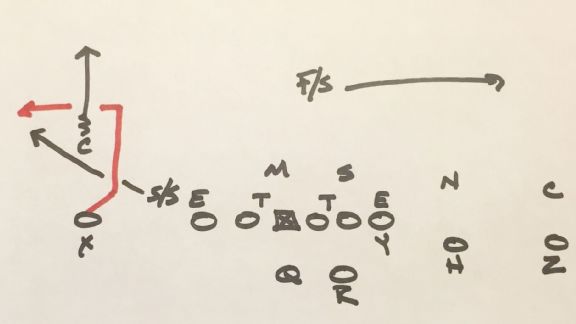
With five defensive backs in the game, we can play combo coverage. The X receiver here is in a reduced split to run the out route. Before the snap, we walk the strong safety (SS) down in a blitz alignment. That tells the quarterback to throw the out (or hot). But with the defense running a "thumbs" technique at the snap, the cornerback drops over the top and the strong safety runs underneath the X receiver. This allows the strong safety to cut underneath the route -- with protection over the top. And it puts our strong safety in a position to potentially get an interception.
Running another "fist" call on the closed side of the formation (2-Man), we're protected there too. The free safety (FS) rolls over the top with the cornerback (C), nickel (N) and Sam linebacker (S) all playing trail-man technique.
Does shadowing work?
During my career, I played with Champ Bailey in Washington. He was the best pure cover corner I've ever seen. I mean, it was like he was dancing with receivers -- step for step. And we did play some matchups with Champ based on game situation and personnel. But he didn't always shadow a receiver.
It's easy to say that a top cornerback should travel all day to take away a specific receiver. But defenses also have to account for motion, stack/bunch looks and slot alignments. The offense is going to set a game plan too. Because of that, and because of coverage schemes that allow you to essentially double a receiver, I love the idea of using my top corner to take out the opponent's No. 2. Just erase him. And now you can go to work on game planning the No. 1.
We have looked at three ways to do that. And no, they are not perfect. You can beat these coverages. But the way I see it, I'm not going to give an elite receiver the chance to beat me. Nope -- the quarterback has to look somewhere else, because I'm taking that guy out of the game.
